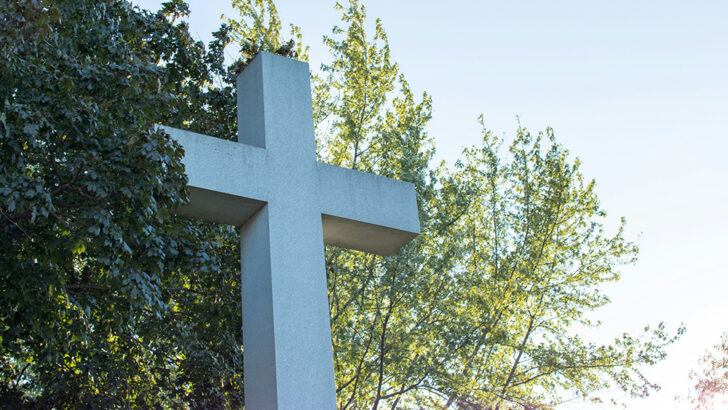The crucifixion of Jesus of Nazareth was a historical event occurring in a particular time and place. But the cross casts a long shadow, one that stretches across all of history. As Christians, we believe that the narrative of human destiny is the story of redemption in the cross of Christ. It stands at the centre of time. Everything before the cross leads to it, and everything that comes afterward flows from it. Marking the intersection of time and eternity, the cross is both the point of inflection and the point of convergence. All things – and all people – meet at Calvary.
Before his election to the papacy, Pope Benedict XVI contemplated an even more mystical notion. In his book, The Spirit of the Liturgy, Ratzinger taught that the shape of creation itself is cruciform, “The sign of the cross is inscribed upon the whole cosmos” (p. 123). Reflecting on the work of St Justin Martyr, the Church’s first philosopher, Ratzinger takes this even further. He says, “The Cross of Golgotha is foreshadowed in the structure of the universe itself. The instrument of torment on which the Lord died is written into the structure of the universe. The cosmos speaks to us of the Cross, and the Cross solves for us the enigma of the cosmos” (Spirit of the Liturgy, p. 124).
Cross
For Ratzinger, however, the cross of Jesus Christ is not merely a static reality, or even the key to understanding the universe. The way of the cross leads us into authentic worship. The cross itself is the way, the road we travel to our final destination in God.
This rings true when we consider the common patterns of growth in the spiritual life. Before we follow Christ, most of us do everything in our power to avoid the cross in all its forms. We run from suffering and keep a safe distance from those who suffer. But that changes when we begin to pursue our faith. It cannot be otherwise, for the Lord’s invitation is clear, “Then Jesus told his disciples, ‘If any want to become my followers, let them deny themselves and take up their cross and follow me’” (Mt 16:24).
We cannot follow Jesus and sidestep the cross. At first, we learn to surrender whatever we suffer to him. We see that the incarnation is not simply a great theological mystery. It opens up for us the possibility of sharing our lives with Jesus, because he came to share his life with us. So, we begin to accept our daily burdens and ask the Lord to carry them with us. Christ becomes part of our life.
As we embrace discipleship more fully, things change again. We learn to offer our crosses up, to unite all that we suffer with the sufferings of Christ. We follow St Paul in “completing what is lacking in Christ’s afflictions” (Col 1:24) by adding ours to his. Through this, our lives become his.
The sign of the cross is a summary of the Gospel. It is God’s signature on creation. The road of discipleship is the way of the cross. Embracing it is the secret path to holiness”
But as we grow deeper in faith, we see that the suffering we experience comes with a hidden gift. Our crosses give us an opportunity to bear a splinter of the cross of Christ. This doesn’t mean we are (or should be) masochists. It does mean that we learn to follow Jesus, not despite the way of the cross, but because of it. It means that we are capable of seeing all things – even what we suffer – as God’s gifts.
Mature disciples understand that offering our suffering to Jesus leads us to something much deeper: the grace to bear some of his. For the saints, this spiritual disposition can take a mystical form as it did for St Teresa of Avila when her heart was pierced by the Word of God in prayer. It can also take a physical form, in martyrdom. Or, as it did 800 years ago, when a seraph gave St Francis of Assisi the stigmata, the wounds of the crucifixion in his own body.
There is no salvation apart from the cross of Christ. The sign of the cross is a summary of the Gospel. It is God’s signature on creation. The road of discipleship is the way of the cross. Embracing it is the secret path to holiness – and there is no other.
Jaymie Stuart Wolfe is a Catholic convert, freelance writer and editor, musician, speaker, pet-aholic, wife and mom of eight grown children.



